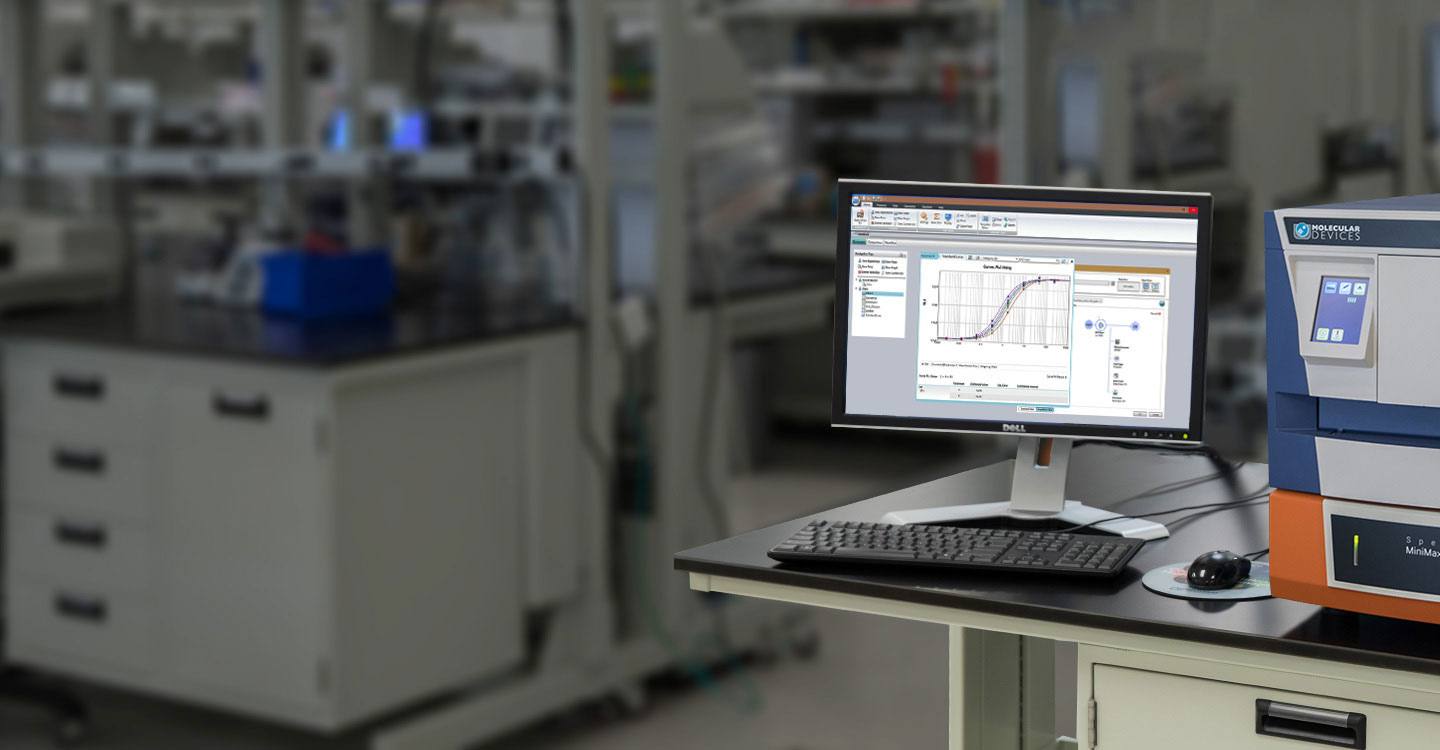What are GxP Software Systems? View 10 Examples
By: Donagh Fitzgerald B.Prod Eng. Last Updated: July 2024

Image: Molecular Devices
GxP is an umbrella term used to describe regulatory guidelines across the pharmaceutical and medical device industries. It encompasses various regulatory guidelines, including:
- Good Laboratory Practice (GLPs)
- Good Clinical Practices (GLPs)
- Good Manufacturing Practices (GMPs)
- Good Distribution Practice (GDPs)
- Good Storage Practices (GSPs)
These sectors use computerised systems to operate and record a range of regulated processes and activities such as manufacturing, product testing, distribution, storage, logistics, etc, These regulated software systems are referred to as GxP Software Systems or GxP computerised systems.
Computer System Validation Course
BTW, if you need to validate these types of GxP software systems to meet regulatory requirements, or if you want to extend your or your team’s role into computer systems validation projects or charge higher hourly rates, check out our 10-week online Computer System Validation Training Course
What types of Computerised Systems are Subject to GXP Regulations?
Let’s take a look at the most common types of GxP software systems that need to be validated along with a brief description of each.
Jump to section:
- Laboratory Information Management System (LIMS)
- Clinical Trial Monitoring Systems
- PLC for Controlled Packaging Equipment
- Supervisory Control and Data Acquisition (SCADA)
- Distributed Control System (DCS)
- Chromatography Data System (CDS)
- Enterprise Resource Planning (ERP) Systems
- Manufacturing Execution System (MES)
- Batch Record System
- Building Management Systems (BMS)
1. Laboratory Information Management System (LIMS)
A Laboratory Information Management System (LIMS) is a type of software that allows you to improve lab productivity and efficiency by tracking a sample from the time it arrives in a laboratory through its testing and storage. This includes recording all data associated with the sample upon its initial accession, such as the sample’s ID, source, collection date, and other information (i.e. concentration, volume, and particulate amount).
As the lab sample progresses along its workflow, additional data is captured, which is also stored in the LIMS. This includes test results, derived sample data, and time-based study metrics. This system allows you to automate workflows, integrate instruments, and manage samples and associated information. Additionally, you can produce reliable results more quickly and can track data from tests over time and across experiments to improve efficiency.
On top of that, a LIMS system can:
- Standardised workflows which reduces human error and increases efficiency.
- Actively manage your entire lab process from instrument maintenance and samples to people and consumables.
- Centralise access and storage of quality control data
- Support your compliance efforts
- Initiate downstream data analysis
- Integrate with instruments or other lab systems to improve lab efficiency
If you’d like to read more on LIMS systems, check out the following link.
Watch this video from Siemens on LIMS
2. Clinical Trial Monitoring Systems
A clinical trial management system (CTMS) is: “a software system used by biotechnology and pharmaceutical industries to manage clinical trials in clinical research. The system maintains and manages planning, performing and reporting functions, along with participant contact information, tracking deadlines and milestones.” (Source: Wilkipedia)
A CTMS allows a company or organisation to streamline the work involved in managing a clinical trial and to get all of the necessary information about that trial. CTMS can be simple or very comprehensive depending on the needs and size of the organisation. Larger pharmaceutical manufactures and biotech companies have massive CTMSs, which take a lot of work to maintain.
Before the use of CTMSs, pharmaceutical manufacturers, biotechnology companies, and contract research organisations (CROs) had to maintain many listings, documents and spreadsheets over the life of a clinical trial which was tedious, time consuming and much more prone to human error. These companies had to track multiple sources of data from different data entry points and that led to duplicate places for data to be captured with no single source for information. In response to these challenges, lots of teams had to create their own homegrown databases to consolidate the work involved in managing clinical trials and this led to the start of the CTMS development.
Check out this video from Bioclinica on a CTMS
3. PLC for Controlled Packaging Equipment
PLC stands for Programmable Logic Controller and is a type of computer used for industrial automation. PLCs are used to control different electro-mechanical processes for use in manufacturing, plants, or other automation environments and can automate a specific process, machine function, or even an entire production line.
PLCs vary in size and shape. Some are small enough to fit in your pocket while others are large enough to require their own heavy-duty racks to mount. Some PLC’s can be customised with back planes and functional modules to fit different types of industrial applications. PLCs are widely used in a variety of industries because they’re fast, easy to operate and are considered easy to program.
Check out this video from RealPars on how PLCs work
4. Supervisory Control and Data Acquisition (SCADA)
SCADA stands for supervisory control and data acquisition. This system can include both software and hardware elements that allows industrial organisations to control industrial processes locally or at remote locations, monitor, gather, and process data in real time, directly interact with devices such as sensors, valves, pumps, motors and record events into a data trail.
SCADA systems are crucial for industrial manufacturing companies as they help to radically boost productivity and maintain efficiency, process data for smarter decisions, and communicate system issues to help mitigate downtime.
“The basic SCADA architecture “begins with programmable logic controllers (PLCs) or remote terminal units (RTUs). PLCs and RTUs are microcomputers that communicate with an array of objects such as factory machines, HMIs, sensors, and end devices, and then route the information from those objects to computers with SCADA software. The SCADA software processes, distributes, and displays the data, helping operators and other employees analyse the data and make important decisions.” (Source: Inductive Automation https://inductiveautomation.com/resources/article/what-is-scada)
Check out this short video from Galco TV on “What is SCADA?”
Check out this longer video from RealPars on how SCADA systems work.
5. Distributed Control System (DCS)
A DCS is a computerised control system for a process or plant made up of autonomous controllers distributed through the system without central supervisory control. It consists of sensors, controllers, and computers that are distributed throughout a plant where each of these elements serves a unique purpose such as data acquisition, process control, as well as data storage and graphical display. These individual elements communicate with a centralised computer through the plant’s local area network generally referred to as a control network.
DCSs are used across the process control industries to supervise complex production processes, they are more widely deployed at large manufacturing plants such as food processing, steel rolling mills, chemical manufacturing, metal refining, petrochemical industry, etc.
Check out this video from RealPars on how DSC systems work.
PLC vs SCADA vs DCS, what is the difference? Watch this video from 4.0 Solutions
6. Chromatography Data System (CDS)
A Chromatography Data System (CDS) is a set of dedicated data-collection tools that integrate with a laboratory’s or facilities chromatography equipment. The system can control and acquire data from chromatography equipment, store that information in a database, interface with other laboratory informatics systems to import and export files and data, record and process that data and generate chromatograms and reports.
The CDS automates the collection of data, allowing analysts to perform tasks without having to manually manage datasets, reducing user-error and ensuring that the information is as robust as possible. It will also ensure that laboratory workflows and practices meet the strict regulatory standards that surround data integrity.
Chromatography labs must be able to provide relevant data trails for auditing while adhering to increasing regulations. Attempting to manually collect and report data without a robust system in place, however, can rapidly become complicated and open to error.
If you’d like to read more on a CDS check out this link.
Check out this link from Thermofisher where they describe their CDS.
7. Enterprise Resource Planning (ERP) Systems
Enterprise resource planning (ERP) is a business process management software that manages and integrates a company’s accounting, procurement, project management, supply chain, operations, commerce, reporting, manufacturing, and human resource activities. ERP systems tie together a multitude of business processes and enable the flow of data between them. These systems collecte an organisation’s shared transactional data from multiple sources helping to eliminate data duplication and provide massive improvements to data integrity.
Watch this video on “What is ERP Software?” by Arcus Universe
Watch this video from SAP
8. Manufacturing Execution System (MES)
A manufacturing execution system (MES) is a piece of software that connects, monitors and controls complex manufacturing systems and data flows on the factory floor and enables manufacturing companies to keep track of and monitor their raw materials and goods.
The main goal of an MES is to get insight into manufacturing operations, analyse what can be done to improve performance as well as to cut costs and maximise production efficiency.
An MES can perform the following functions:
- Collect real-time data: Since MES systems are integrated right into factory machinery, information is collected in real–time to keep track of production efforts.
- Enable production analysis: A way to gain insight into manufacturing operations including resource use, production cycle time and scheduling conformance.
- Enforce process requirements: By having an enforced process, steps are in place to make sure every product is built to spec. For example, if a machine requires three parts to interlock, the machine knows to expect these three particular parts to fit in place and will not run if there are only two parts inserted or, more likely, the operator mis-positioned one of them.
Watch this video from GE Digital on “What is an MES?”
9. Batch Record System
The pharmaceutical or biopharmaceutical manufacturing industry is regulated by GMPs which requires that the production process is thoroughly documented.
A batch record is a product quality controlled document that collects all the data and information such as materials, equipment, people, data, labels and events during the production of a regulated product. This record allows the manufacturer to answer questions that are critical to product quality, such as; Who did what, and when? Which materials were used? Which procedures were followed and were the results within specifications?
More recently the industry has moved away from collecting this data manually and moved its collection to an electronic batch record system.
Watch this video from MyCellHub on “What is a batch record?”
10. Building Management Systems (BMS)
A Building Management System (BMS) is an automated control system that is used to manage a building’s building’s mechanical and electrical equipment such as heating, lighting, ventilation, air conditioning, security, fire protection systems, and so on.
It is made up of many different input and output subsystems controllers, servers, and workstations communicating over a control network to monitor, alarm and trend the equipment. BMSs are also referred to as Facilities Management/Monitoring Systems or Building Automations Systems.
Watch this video from Airedale International Air Conditioning Ltd on “What is a BMS?”
You might also be interested in.
About the Author
Donagh Fitzgerald
Head of Marketing & Product Development
Mechanical/Production Engineer
Donagh looks after the marketing and product development including the training and pedagogical elements of our programs and makes sure that all GetReskilled’s users can have a great online learning experience. Donagh has lived and worked in many countries including Ireland, America, the UK, Singapore, Hong Kong and Japan. Donagh has also served as the Program Manager for the Farmleigh Fellowship based out of Singapore.
Donagh holds Degrees in Production Engineering and Mechanical Engineering from South East Technological University, Ireland.
